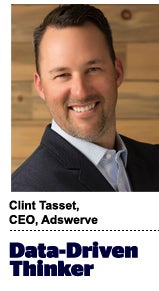“Data-Driven Thinking” is written by members of the media community and contains fresh ideas on the digital revolution in media.
Today’s column is written by Clint Tasset, CEO of Adswerve.
New data privacy legislation and shifting first-party data strategies will challenge marketers in 2022. But it’s talent that’s topping their list of concerns this year.
As marketing professionals seek a life-work balance that maximizes their autonomy and better aligns with their values, the “Great Resignation” will continue to cause far-reaching ripple effects.
Employees’ expectations have changed. Without commutes, they have more free time. They’ve learned to stack work and life tasks. (Who hasn’t made a sandwich while sending a Slack?) And they’ve realized that virtual meetings work just fine.
How worried should leaders be? One study says nearly half of marketing professionals (48%) have considered a career change, and 75% of employers expect more mass resignations.
As this reprioritization occurs, employers are rethinking traditional work values and structures. With so much fresh talent, it’s time to infuse your teams with highly motivated new members that can drive innovation. But what will it take to attract and retain them?
Tapping into the a new-age talent pool
The advertising job market has always been dynamic. But remote work will make for an especially unique talent pool. Here are three factors to consider:
1. Mature in-housing: Over the next year, the industry will become more prescriptive, specific and organized around in-housing efforts. In the face of depleting cookies and privacy changes, we must be prepared to shift from tech-focused partnerships to service-led partnerships – or, in an ideal scenario, finding a partner that does both.
We’ll see marketers continue to own and control contracts and data but engage with partners that offer a wider view of the ad marketplace, expert advice on architecture and better performance.
2. The upside of the Great Resignation: When team members leave, they don’t just leave a job vacant; they take institutional knowledge, intuition, relationships and ideas with them.
But in 2022, companies need to shake off the disruption and get excited about the diverse and motivated emerging pool of talent.
Organizations also need to adjust onboarding and hiring practices to accommodate this talent by investing in more training and benefits that fit the new realities of the workforce. Flexible workweeks and workdays are increasingly attractive, as are companies that have more decentralized offices.
3. A return to (missing) the office: The newfound freedom many employees have while working from home has changed our professional way of life. Most would argue that there’s no going back. But the future is not as binary as it seems.
I predict that, in 2022, we’ll start seeing some employees get the urge to return to the office more frequently or participate in “normal” activities like conferences, travel and team-bonding activities.
2022 will be about employees reestablishing and reenvisioning what motivates them. We can’t discount that some of these things may involve more traditional office settings.
Last year brought a seismic shift in talent. 2022 will bring a similarly significant infusion of talent into the advertising and marketing industry. Companies that support this transition and lean into the changing talent landscape will emerge stronger, fortifying their teams with a workforce that can withstand the next great talent evolution.
Follow Adswerve (@AdswerveInc) and AdExchanger (@adexchanger) on Twitter.













